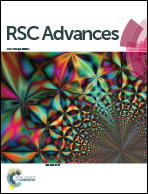Wearable triboelectric nanogenerators based on hybridized triboelectric modes for harvesting mechanical energy†
Abstract
In this paper, we demonstrate a newly designed hybridized triboelectric nanogenerator (TENG) fabric incorporating multiple working modes, which can effectively harvest ambient mechanical energy for conversion into electric power by working in a hybridization of a contact–separation mode, a sliding mode and a freestanding triboelectric layer mode. The power generation of each mode of the TENG fabric was systematically investigated and compared along different directions, under different frequencies and at different locations. Owing to the advanced structural design, the as-fabricated TENG fabric could be switched between multiple working modes according to its real working situation. High output voltage and current of about 140 V and 0.6 μA, respectively, were obtained from a larger size of TENG fabric, which could be used to light up 120 LEDs in series. Compared to the previously reported TENGs, such a hybridized TENG fabric based on hybridized modes has much better adaptability for harvesting energy (such as human walking, running, and other human motion) in different directions. This work presents the promising potential of hybridized TENG fabric for power generation and self-powered wearable devices.



 Please wait while we load your content...
Please wait while we load your content...